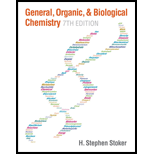
Concept explainers
(a)
Interpretation: To determine the number of phosphorus-oxygen bonds that is broken in the conversion of ADP to AMP via a hydrolysis reaction.
Concept introduction: High energy compounds are those compounds that release a large amount of energy upon hydrolysis. These compounds consist of highly strained bonds which are responsible for the release of a high amount of energy. The compounds containing a phosphate group are examples of high energy compound. ADP and AMP are examples of high energy compounds.
ADP and AMP contain the adenine base, the ribose sugar unit and phosphate groups in their structure. They only differ in the number of phosphate group present in them. Adenosine diphosphate (ADP) consists of two phosphoryl groups
(b)
Interpretation: To determine the number of phosphorus-oxygen bonds formed in the conversion of ADP to AMP via a hydrolysis reaction.
Concept introduction: High energy compounds are those compounds that release a large amount of energy upon hydrolysis. These compounds consist of highly strained bonds which are responsible for the release of a high amount of energy. The compounds containing a phosphate group are examples of high energy compound. ADP and AMP are examples of high energy compounds.
ADP and AMP contain the adenine base, the ribose sugar unit and phosphate groups in their structure. They only differ in the number of phosphate group present in them. Adenosine diphosphate (ADP) consists of two phosphoryl groups
Want to see the full answer?
Check out a sample textbook solution
Chapter 23 Solutions
GENERAL,ORGANIC,+BIO.CHEM.-MINDTAP
- Lithium ion inhibits the synthesis of inositol trisphosphate by inhibiting a reaction in the breakdown of inositol trisphosphate.Explain this apparent paradox.arrow_forwardLithium ion inhibits the synthesis of inositol trisphosphate by inhibiting a reaction in the breakdown of inositol trisphosphate. Explain this apparent paradox.arrow_forwarda. Use the values in Problem 23.31 to calculate the energy change in the following reaction. fructose 1,6-bisphosphate + ADP--------> fructose 6-phosphate + ATP b. Is this reaction energetically favorable or unfavorable? c. Write this reaction using curved arrow symbolism. d. Can this reaction be used to synthesize ATP from ADP? Explain.arrow_forward
- Suggest a name for the enzyme that catalyzes each of the following reactions. a. transfer of a phosphate from ATP to glycerol b. addition of water to fumarate c. isomerization of glucose 6-phosphate to fructose 6-phosphatearrow_forwardFigure 1 shows the catalytic triad of a-chymotrypsin. Identify A, B and C. Describe the subsequent steps of stage 1 and stage 2 of a- chymotrypsin mechanism. Illustrate with diagrams. A B CH2 H-N N: H-O Figure 1arrow_forwardFour protons are required to drive the phosphorylation of ADP. Account for the function of each proton in this process.arrow_forward
- A point mutation in Hb diminishes hydrophobicity at the heme. Which of the following impacts would you predict? . Increased oxidation of Fe2+ and loss of O2 binding b. Decreased negative charges needed at the dimer/dimer interface to stabilize the T-state c. Decreased positive charges needed at the dimer/dimer interface to stabilize the T-state d. Shift the O2 binding curve of Hb to the left e. Decreased affinity for BPG in the T-statearrow_forwardBriefly describe how cyclic AMP controls phospholipid synthesis.arrow_forwardIndicate at what step number in the glycolysis pathway the following event occur and why? a. First isomerization reaction occurs FOLLOW THE INSTRUCTIONS!arrow_forward
- The diagram below shows an outline of the aminotransferase mechanism that skips the specific steps that show how electrons flow when a Schiff base is formed or is hydrolyzed. Using the mechanistic details given below A. Draw the mechanism for Enzyme- PLP Schiff base formation using pyridoxal and the lysine amine group using arrow to indicate electron flow. B.Draw the mechanism for hydrolysis of the Schiff base to form the a-keto acid, which is the reverse of the first reaction.arrow_forwardMatch the enzyme name to the description of the type of reaction that it catalyzes. Each choice can only be used once. 1. Transfers a hydride ion in a redox reaction and decarboxylates. 2. Forms a double bond through a dehydration reaction. 3. Combines an aldose and a ketose together in the first step and then cleaves the intermediate molecule into a new aldose and new ketose. Is NOT sensitive to a Vitamin B1 deficiency. 4. Acts as both an enzyme and a scaffold for the formation of a glucose homopolymer. 5. Transfers the gamma phosphoryl group from ATP to a carbohydrate. answer choices: a. glycogen synthase b. glycogenin c. enolase d. PFK-1 e. G6P f. transketolase g. transketolase h. glyceraldehyde 3 phosphate dehydrogenase i. 6 phosphogluconate dehydrogenase Please answer completely will give rating surelyarrow_forwardExplain why catalase activity is lower at: i. Low temperature ii. High temperaturearrow_forward
 Human Anatomy & Physiology (11th Edition)BiologyISBN:9780134580999Author:Elaine N. Marieb, Katja N. HoehnPublisher:PEARSON
Human Anatomy & Physiology (11th Edition)BiologyISBN:9780134580999Author:Elaine N. Marieb, Katja N. HoehnPublisher:PEARSON Biology 2eBiologyISBN:9781947172517Author:Matthew Douglas, Jung Choi, Mary Ann ClarkPublisher:OpenStax
Biology 2eBiologyISBN:9781947172517Author:Matthew Douglas, Jung Choi, Mary Ann ClarkPublisher:OpenStax Anatomy & PhysiologyBiologyISBN:9781259398629Author:McKinley, Michael P., O'loughlin, Valerie Dean, Bidle, Theresa StouterPublisher:Mcgraw Hill Education,
Anatomy & PhysiologyBiologyISBN:9781259398629Author:McKinley, Michael P., O'loughlin, Valerie Dean, Bidle, Theresa StouterPublisher:Mcgraw Hill Education, Molecular Biology of the Cell (Sixth Edition)BiologyISBN:9780815344322Author:Bruce Alberts, Alexander D. Johnson, Julian Lewis, David Morgan, Martin Raff, Keith Roberts, Peter WalterPublisher:W. W. Norton & Company
Molecular Biology of the Cell (Sixth Edition)BiologyISBN:9780815344322Author:Bruce Alberts, Alexander D. Johnson, Julian Lewis, David Morgan, Martin Raff, Keith Roberts, Peter WalterPublisher:W. W. Norton & Company Laboratory Manual For Human Anatomy & PhysiologyBiologyISBN:9781260159363Author:Martin, Terry R., Prentice-craver, CynthiaPublisher:McGraw-Hill Publishing Co.
Laboratory Manual For Human Anatomy & PhysiologyBiologyISBN:9781260159363Author:Martin, Terry R., Prentice-craver, CynthiaPublisher:McGraw-Hill Publishing Co. Inquiry Into Life (16th Edition)BiologyISBN:9781260231700Author:Sylvia S. Mader, Michael WindelspechtPublisher:McGraw Hill Education
Inquiry Into Life (16th Edition)BiologyISBN:9781260231700Author:Sylvia S. Mader, Michael WindelspechtPublisher:McGraw Hill Education





